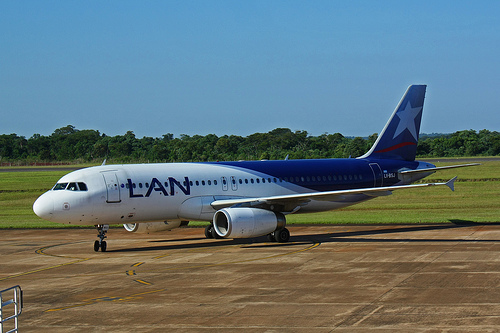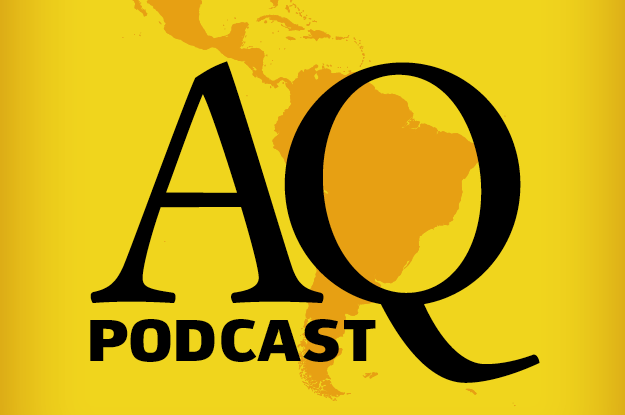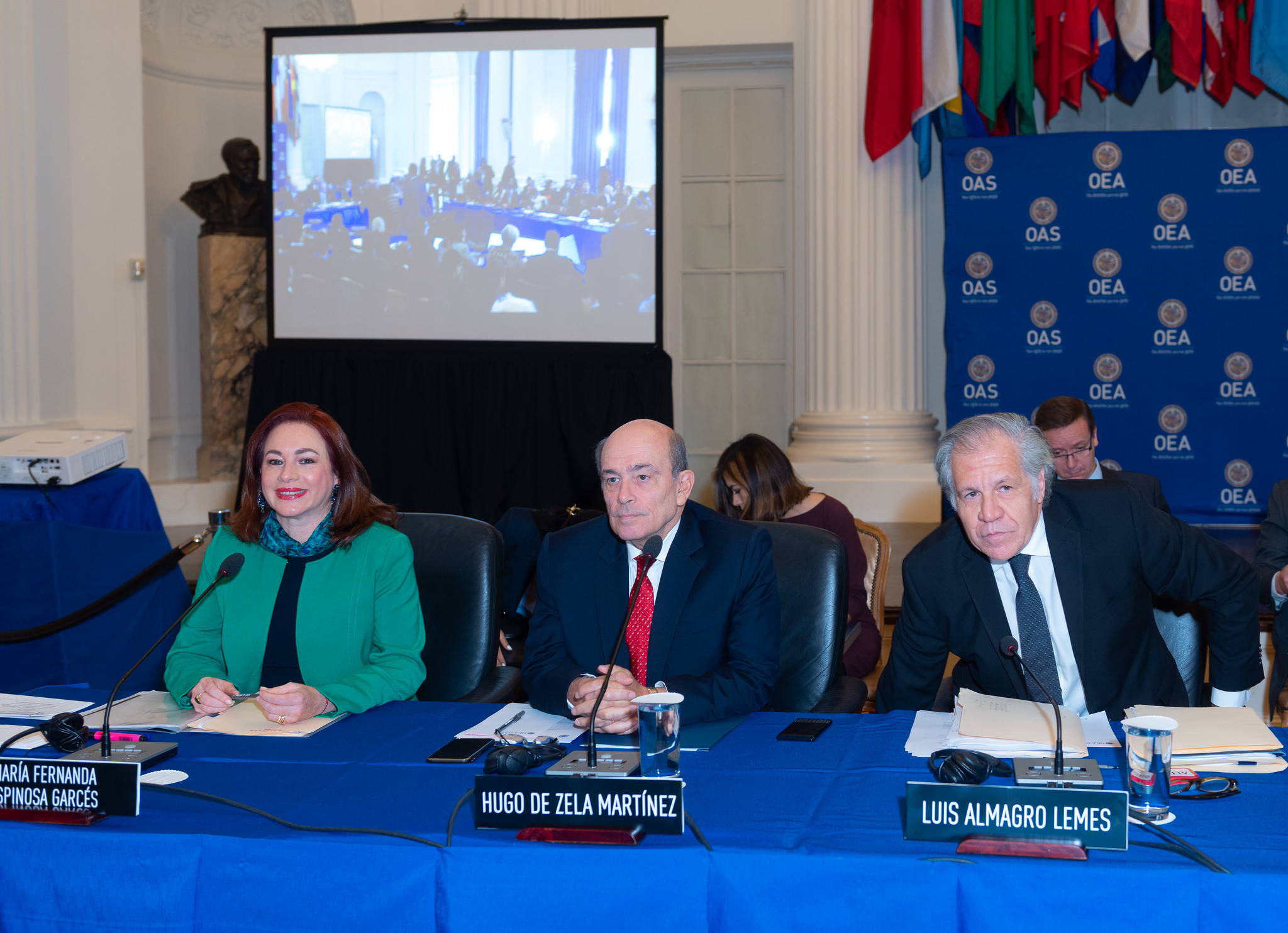Relations between neighboring Argentina and Chile have reached a new low point. The latest controversy surrounds a decision by Argentina’s airport regulator, ORSNA, mandating LAN-Argentina, a Chilean-owned airline operating domestically, to vacate its maintenance hangar at Aeroparque Jorge Newbery, one of Buenos Aires’s two airports. LAN-Argentina’s director, Agustín Agraz, called this decision a form of “intimidation.”[1]
The controversy is now involving the upper echelons of both governments. Chilean President Sebastián Piñera instructed his foreign minister, Alfredo Moreno, to intercede.[2] A meeting took place between Moreno and his Argentine counterpart, Héctor Timerman, which, according to rumors, did not go well. Chilean officials expressed dismay, anger and frustration, and the Argentines refused to budge. Days later, Argentine President Cristina Fernández de Kirchner publicly took sides with the airport regulator.
Why this Anger?
To understand why LAN and Chile’s political establishment are so angry over the hangar affair, it helps to understand the airport situation in Buenos Aires, and the state of Argentine-Chile relations.
Essentially, the Argentine government is asking LAN to move its hangar to Ezeiza. This will no doubt undermine LAN-Argentina’s capacity to compete domestically. Ezeiza and Aeroparque are to Buenos Aires what Kennedy and La Guardia airports are to New York City.
Ezeiza and Kennedy are larger, but they are farther from downtown. Rush hour traffic can more than double the 50-minute downtown-to-airport commute. There are also expensive tolls. Ezeiza, like Kennedy, is used mostly for international routes, with domestic routes playing a secondary role. In contrast, Aeroparque, like La Guardia, is closer to downtown—in fact, Aeroparque sits right in downtown Buenos Aires—and it is used mostly for domestic routes. In 2012, Aeroparque offered 295 daily flights: 190 mostly domestic routes operated by Aerolíneas and Austral, followed by LAN Argentina, with 55 domestic flights and six regional flights.[3]
Domestic passengers in Buenos Aires prefer the convenience of Aeroparque for flying domestically. That is why LAN needs a big presence in Aeroparque. Moving the hangar to Ezeiza would cause LAN to offer fewer flights out of Aeroparque, and to lose passengers who would prefer not to commute to Ezeiza to catch a domestic flight.
Furthermore, LAN claims the issue has to do with property rights and equal protection under law. LAN invested $5 million to renovate what used to be a dilapidated hangar, and pays $20,000 a month in rent under a contract that runs through 2023.
The Chilean government feels that the Aeroparque affair is part of a long list of trade-related issues (e.g., exports of Argentine national gas, tariffs on Chilean imports and regulatory treatment of Chilean investments) in which Argentina often discriminates against Chile. It argues that cooperation between countries requires treating foreign investors equally and respecting contracts. By siding with LAN, Chileans seem to have finally decided to take a stronger stand against Argentina.
Argentina claims that Aeroparque is saturated and that it is Chile that violates reciprocity. President Fernández said this week that Argentina allows foreign carriers to operate domestically and the opposite is not true.[4] In reality, it was the president’s statement that proved to be not entirely true. Between 2004 and 2008, an Aerolíneas subsidiary operated domestic flights in Chile and had to shut operations due to company losses, not government-imposed barriers.
Explaining Argentina’s Motives
The reason behind Argentina’s decision boils down to protectionism. LAN-Argentina is a privately owned firm that is highly efficient, profitable, reliable, and competitive. It is owned by LATAM, a remarkably successful multilatina. LATAM resulted from the merger between Chilean LAN and Brazilian TAM in 2012, the largest cross-border transaction conducted in Latin America that year.[5]
In an industry that has seen so many firms disappear or suffer heavy losses, LATAM has expanded phenomenally by establishing subsidiaries in Brazil, Argentina, Peru, Ecuador, and Colombia, operating one of the most modern fleets in the Americas and providing reliable service. LAN-Argentina employs close to 3,000 workers in Argentina, and competes with Aerolíneas Argentinas for domestic passengers in about 14 routes.
Aerolíneas is the opposite of LAN: it is public, inefficient, loss-making, and highly subsidized. In 2012, it received close to $4 billion in state subsidies.[6]
To deal with Aerolíneas’s competitiveness problems, the state faces two options: either make the airline more efficient (reduce costs, fire underperforming personnel, invest in new technology, establish a competitive fare structure, stimulate demand, manage inventory better) or it could reduce the size of its competition. By forcing LAN to move its hangar from Aeroparque, the state is choosing the latter.
There is evidence that lack of competition in Argentina’s aviation sector has been detrimental to consumers but good for the monopolist. On city-pairs where Aerolíneas faces no competition, fares can be twice as high relative to similar city-pairs with competition. According to economist Federico Sturzenegger, flying from Buenos Aires to Bariloche costs approximately 1,800 pesos, but flying to San Martín de los Andes, which is only 70-miles away from Bariloche but served only by Aerolíneas Argentinas, costs 3,500 pesos.
Of the five largest Latin American economies—Brazil, Mexico, Argentina, Chile, and Colombia—Argentina probably has the least competitive and most underfunded aviation environment. The result has been an embarrassingly underdeveloped sector.
According to economist Diego Cabot, domestic air markets have expanded almost everywhere in the region. However, in Argentina, the market, at 7.4 million annual travelers, is only slightly larger than in 1999, when the market reached 7.0 million. This low growth occurred despite Argentina registering one of most impressive economic growth rates in the region since 2002.[7]
Cabot argues that one way to understand the underdevelopment of Argentina’s domestic aviation market is to compare it to Chile. Both markets have similar numbers of annual domestic passengers. But Chile is far smaller and less populous, with 17.2 million inhabitants versus 40.7 millions in Argentina. He cites studies showing that if one takes into consideration flights per capita, Argentina is below Bolivia, Peru and El Salvador—all three far poorer and smaller than Argentina.
To be fair, Argentina’s aviation problems are not all state-inflicted. The country suffered a severe depression in 1999–2001 that decimated the domestic market. More seriously, the previous owners of Aerolíneas, which was privatized in 1991 and was partially owned at different points by IBERIA of Spain, several banks, American Airlines, and lastly, Grupo Marsan, a Spanish investment company, did much damage. They established a near-monopoly of domestic service and reduced Aerolíneas’s inventory by cutting service and selling planes—the so-called “vaciamiento de Aerolíneas.” No doubt, Aerolíneas proved up until 2008 that private monopolies can be nepharious, especially foreign-owned ones.
But the sad story is that the Argentine government has fought private monopolies by replacing them with public monopolies. It expropriated Aerolíneas in 2008. Unable to turn Aerolíneas around, and unwilling to increase investments in the aviation sector, the state is now trying to reduce Aerolíneas’s domestic competition.
The Politics of Argentine Protectionism
Argentina has always had a pronounced protectionist proclivity. Except for a few brief instances in the late 1970s, and during the Carlos Menem administration [1989 –1999], when the country introduced market reforms, the Argentine state has always embraced a preference for one-way globalization: other nations should open their markets to Argentine products (meat, grains, tangos, wine), but not necessarily the other way around.
This protectionism has always been electorally rewarding in Argentina. Both protected businesses and agro-exporters love it, leading to a coalition that is reminiscent of the “iron and rye” coalition of protected industrialists and landowners that supported the German empire in the late nineteenth century.
But the Argentine version of this protectionist coalition is more complex. It includes ruling party members and ideologues across the electorate.
Ruling party members come into the picture because Argentina’s protectionism has always privileged state-owned firms, and these firms are typically staffed by ruling party figures. These party figures in turn extract multiple political benefits from running state-owned enterprises.
Under the Fernández (and her late husband, Néstor Kirchner) administration, the faction of Peronism known as La Cámpora has taken control of most state-owned companies. La Cámpora uses those firms to wield power, offer (or deny) contracts to private actors and draw resources to channel them into political objectives. The less competition these firms face, the more resources La Cámpora can amass for non-business activities.
Argentina’s entire aviation sector has fallen under the control of La Cámpora. [8] The current CEO of Aerolíneas Argentinas (and subsidiary Austral), Mariano Recalde, is a self-declared member of this group.[9] On Tuesday, a video surfaced on social media showing Recalde in 2010 asking President Fernández to take away some routes from LAN-Argentina. Likewise, the head of OSNAR, Gustavo Lipovich, is another member of La Cámpora. He was also part of Aerolínea’s management team, and at least until June, still listed under Aerolíneas’s payroll.[10] This all seems to prove the existence of a ruling party-brokered collusion between a state-owned firm and a state regulator to diminish competition.
Protectionism in Argentina has also proved rewarding by appealing to nationalist ideologues. The reason is that protectionism in Argentina was always directed against “the West:” first against England, which up until the 1940s was Argentina’s largest foreign investor, and since then toward the United States.
Because protectionism in Argentina was always painted with anti-imperialist colors, many Argentines welcomed it. As consumers, Argentines always lose from protectionism, but as proud anti-Imperialists, they feel empowered by it.
Latin Protectionism in the Era of Multilatinas
The problem with protectionism today is that in this post-hegemonic world characterized by the decline of the West, the rise of the rest and the emergence of multilatinas like LATAM, this economic orientation is more likely to pit nations in the South against peers than against traditional powers in the North. This is what is happening in Argentina today: the state’s effort to defend its archaic iron-rye-ruling party coalition is creating unnecessary conflict with a neighbor, which incidentally, is one of Argentina’s most important trading partners. In 2012, Argentina’s trade surplus with Chile reached $4 billion, almost a third of Argentina’s total trade surplus.
Government supporters are trying to portray this fight with Chile in traditional populist terms. They argue that it is a question of sovereignty and decency. Some have gone as far as to claim, in the style of late Venezuelan President Hugo Chávez, that LAN has ties to fascism (in Chile) and to the destabilizing opposition (in Argentina).
Argentina is shooting itself in the foot by picking this fight with Chile. At a time when Argentina is being eclipsed by the rise of Brazil, and its second-best ally in the region, Venezuela, is losing influence, it is in Argentina’s interest to cultivate better relations with Chile, if for no other reason than as a way to counterbalance Brazil.
The country also is facing a losing battle against inflation, and the state should welcome any business opportunity that promises lower prices for Argentine consumers. Similarly, at a time when Argentina is having trouble renegotiating the last holdout of its debt, the last thing the state needs now is an affair that signals to investors that that they can be adversely treated at any time.
Chances are that the Argentine government will eventually yield. Chile is too important a neighbor. Although Argentines have had an historical animosity with Chile, most polls suggest that the electorate is not interested in silly fights with Chile any longer. At the same time, the Argentine courts are not that subservient to the Executive branch, and on Wednesday, a court blocked the eviction of LAN-Argentina from its hangar, at least for the time being.
The problem is that, while the Argentine government will probably change its position vis-à-vis LAN-Argentina, it seems unlikely to change its position vis-à-vis its iron-rye-party protectionism. And as long as this protectionism endures, Argentina will be afflicted by corruption, collusion, inflation, and poor services.
The Kirchners and the faction of Peronism that came to power in 2003 managed to win popular approval by offering to fight these governance ills. But the economic model that they have set in place is locking Argentina into a position from which it can never be saved.
[1] http://www.infolatam.com/2013/08/26/an-recurre-ante-justicia-expulsion-de-aeropuerto-argentino/
[2] http://www.economiaynegocios.cl/noticias/noticias.asp?id=111666
[3] http://www.emol.com/noticias/economia/2012/10/18/565299/impulsan-el-uso-del-aeroparque-para-lineas-argentinas-y-se-desalojaria-a-lan-tam-y-gol.html
[4] http://www.clarin.com/politica/vuelos-cabotaje-Presidenta-pidio-reciprocidad_0_982701757.html
[5] http://blogs.r.ftdata.co.uk/beyond-brics/files/2013/05/Multilatinas.pdf
[6] http://www.infobae.com/2013/06/24/716958-el-pago-salarios-insume-la-mayor-parte-los-subsidios-aerolineas
[7] http://www.lanacion.com.ar/1613564-mucho-peso-a-la-hora-de-volar-fallas-estructurales-en-el-mercado-aerocomercial
[8] http://www.lanacion.com.ar/1612797-el-gobierno-intimo-a-lan-a-dejar-un-hangar-en-aeroparque-y-peligra-su-operacion-en-el-pais
[9] http://www.clarin.com/politica/Recalde-ironia-Campora-cuco_0_983301705.html
[10] . http://www.perfil.com/economia/El-regulador-aereo-un-tuitero-anti-LAN-que-es-empleado-de-Aerolineas-20130823-0082.html









